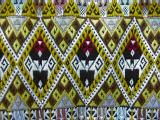 THAILAND--Part Nine
THAILAND--Part Nine
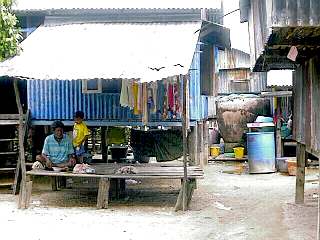
The
first place we visited was a small fishing village called Ko Sire, on
the island of Phuket in the Andaman Sea on the west coast. The village
is dominated by the sea gypsies who live there and make their way by,
of course, fishing. Some of the gypsies we saw don't actually live at
Ko Sire, but rather stay on their boats and move daily from one village
to another. The atmosphere of Ko Sire was very slow and laid back, as
you might expect on a tropical beach. Unfortunately, this lifestyle is
threatened by huge commercial operations that over-fish the waters of
the area, leaving little for these small-scale fishermen who depend on
the fish for their livelihoods.
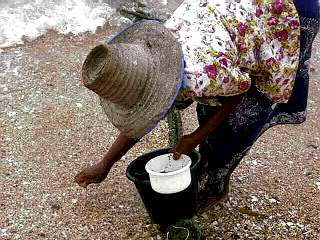
Out
on the water, we saw this woman pulling something out of the sand. When
we got closer, I could see she was gathering long, cream-colored worms
from under the surface. I couldn't figure out how she could see them,
so she showed me (with my friend's help as translator). She'd wait for
a wave to come in, then when it receded she'd look for a little air pocket
on the surface of the sand -- a sure sign a worm was waiting underneath.
I could see what she was doing, I guess, but I sure couldn't do it myself!
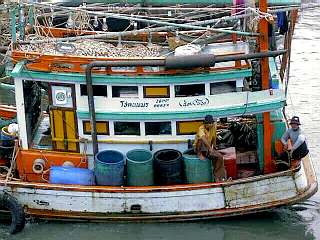
These
are the types of boats you see going around the area competing with the
sea gypsies for fish. I'm not sure if this one belongs to one of the big
companies or just a smaller local group, but they certainly catch a lot
more fish than the sea gypsies do.
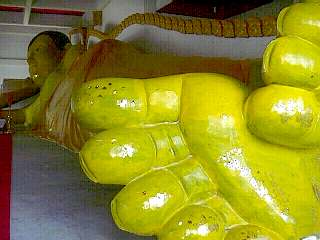
Though
I expected to see more Muslim influence, Ko Sire and Phuket are still
far enough north that Buddhism maintains its dominant position. This huge
Buddha lies in a temple atop a hill overlooking the fishing village. Check
out the gold leaf followers have applied to his toes in offering.
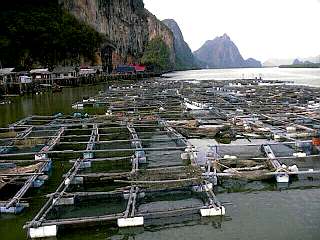
Up
the coast a bit and near the town of Phang-Nga, we took a boat out to
a small Muslim fishing village on he island of Ko Panyi. The area around
it is gorgeous, dotted with small karst (a kind of limestone) islands
that had eroded away to create these craggy eruptions out of the water.
Near the island we saw these fish ponds, which may represent part of the
answer to the sea gypsies' dilemma: if more fish can be caught in ponds
like this, then allowed to produce more and more offspring, much of the
incentive for big companies to overfish the coasts may be lost, and the
sea gypsies will find better fishing again.

This
mosque in Ko Panyi was my first evidence that we were heading into more
Muslim areas. We were greeted by this charming young girl named Layla,
who offered to show us around the village (for a price -- 200 baht (!),
which we negotiated down to 20 baht, a more reasonable price considering
it only took ten minutes to walk around the whole place). She was hilarious,
though not the greatest guide. "What do you want to see?", she asked us.
"I don't know", my friend replied, "what is there to see?" "Wanna see
a supermarket?", she offered back. "Sure -- which way is it?" "I don't
know!" was her answer, as she hunched up her shoulders and raised her
palms in the air to show us she had no idea. We almost rolled on the ground
in laughter.
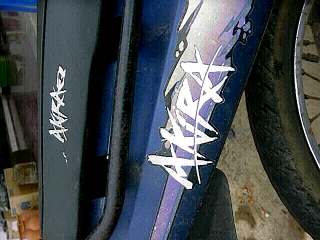
Back
on solid land, we came into the town of Krabi. Here, we saw this motorbike,
which is on the website only because it bears the name of one of my former
students and I want to see if she's awake.
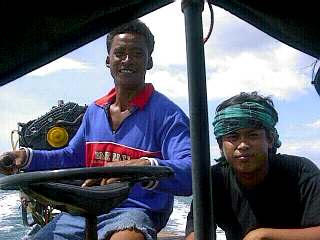
Farther
down the coast, we decided to get away from the tourists and go out to
an almost-deserted island called Ko Kradan. (If you haven't figured it
out yet, ko is the Thai word for "island".) It was fantastic --
there was coral not twenty feet out from the shore, and we spent the day
out snorkeling and checking out thousands of colorful fish. The way out
wasn't as much fun, though, as we had to take a ninety-minute trip out
to the island on a small long-tailed boat through a fierce storm. (This
photo is of the boat drivers on the way back, when the weather was much
nicer.) I was lucky not to get sea-sick, but my friend wasn't so fortunate.
We had to laugh when we got to our bungalow, though: we were soaking wet,
and there were no towels, but there WERE two shower caps sitting on our
beds in anticipation of our arrival. Only in Thailand.
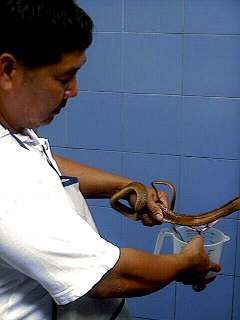
Our
next step was Hat Yai, the commercial capital of southern Thailand and
getting very close to Malaysia. Here, we found a very curious shop on
Thanon Nguu ("Snake Street"). The proprietor would grab an angry cobra
out of its cage (with a long pole, of course), slice open its still-writhing
body...
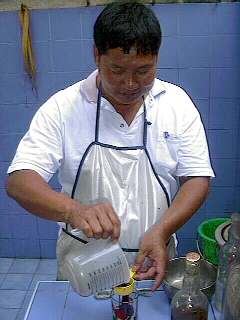
...and
drain the blood into a glass. He'd then mix the blood with honey and rice
wine...
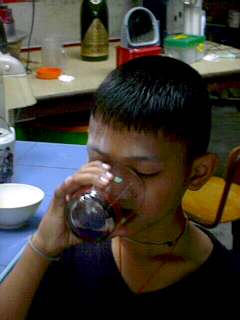
...and
serve it to a waiting customer. This is supposed to make you feel strong
and vital. Not for the faint of heart. I decided to pass.
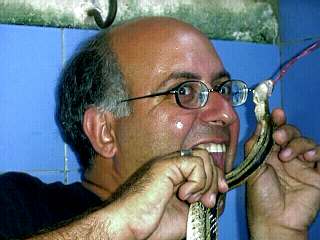
On
the other hand, a little fresh snake meat never hurt anyone, right?
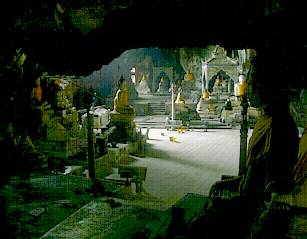
Farther
south, outside the city of Yala, we visited a famous Buddhist monument
(one of the three most important in southern Thailand) named Wat Naa Tham.
I figured this would be my last chance to see a Buddhist temple for a
while, so we went. (By this part of Thailand, there is an unmistakably
strong Muslim feel; Buddhist temples are far outnumbered by mosques, and
you're awakened by the call to prayer in the middle of the night.) This
was a really incredible place, because it was inside a cave.
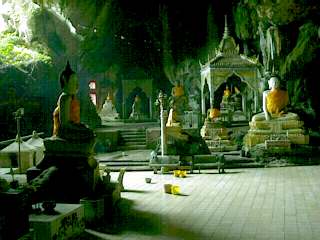
Going
deeper inside, you could see that there were literally hundreds of Buddha
figures.
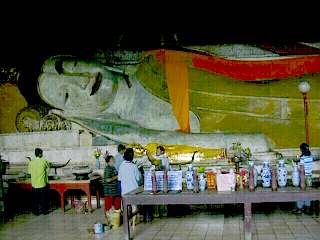
And
all the way inside was this monstrously huge Buddha image named Phra Phutthasaiyat.
It was sculpted over 1000 years ago, in about 750 CE, during the time
when southern Thailand was ruled by the great Srivijayan empire centered
on the present-day Indonesian island of Sumatra. I'm always amazed by
how things change over time -- to think that a Buddhist city in Indonesia
ruled over parts of Thailand is incredible to me -- and yet how they stay
the same -- this Buddha image is still here!
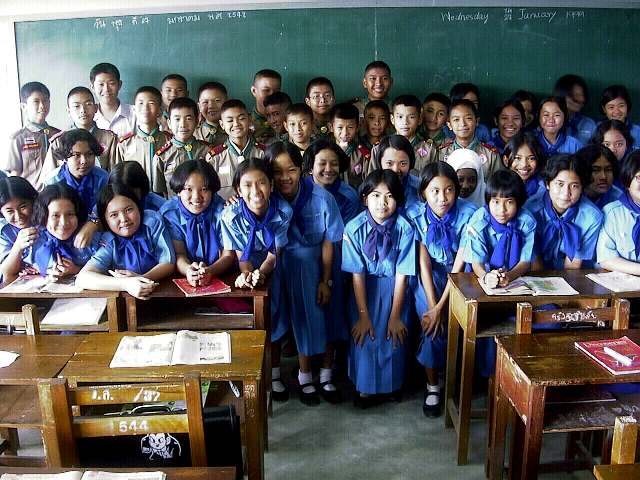
At
the very southernmost part of Thailand, right on the border with Malaysia,
sits the town of Betong. Being that far from most of Thailand (it's over
1000 kilometers from Chiang Mai), it seems more Malaysian than Thai in
a lot of ways. (There has been a long-standing movement to make this part
of Thailand a part of Malaysia, which many people here feel it has more
in common with.) Part of this Malaysian character is that many people
speak English, which is Malaysia's second language -- check out the Malaysia
section of the site to see why. Lots of people speak Chinese languages,
too. Anyway, while having dinner the night we arrived, I met a school
teacher named Mrs. Parichat who invited me to visit her classroom. I didn't
have a lot of time to spend the next day, but I did go there long enough
to just get a glimpse of her class and meet with the teacher in the computer
lab. That was enough to set it up as another place for you to write, if
you wish -- and it looks like a really interesting place, especially being
on the border between two very different countries. So, if you would
like to write to students at Betong Wir... School, just click
here.
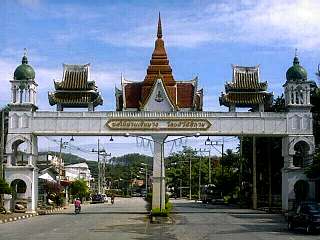
My
last sight of Thailand was a really interesting one. This is the gateway
leading out of Betong, which is designed to symbolize the coming together
of three cultures in the city -- Malay (the mosque turrets at either end,
which are shaped like onions), Chinese (the curved temple roofs) and Thai
(the Buddhist stupa in the center). To me, this is a perfect symbol of
what Thailand is all about: the coming together of many influences to
create a truly fascinating multicultural society.
|
On leaving Thailand, I found myself having missed seeing several things I really wanted to see and share with you. Of course, in a nation as diverse as Thailand, there will always be so much I would have missed -- yet so much I DID see, too. There's so much more, though, and I hope some of you are interested enough to check out some books or browse the web to find out more. (If you find good sites, please tell me and I'll put links into the site to get to them.) If you've found this interesting, I think you'll find the next leg of my journey just as fun to follow. So, join me as I go to farther south and into the fascinating country of MALAYSIA! |